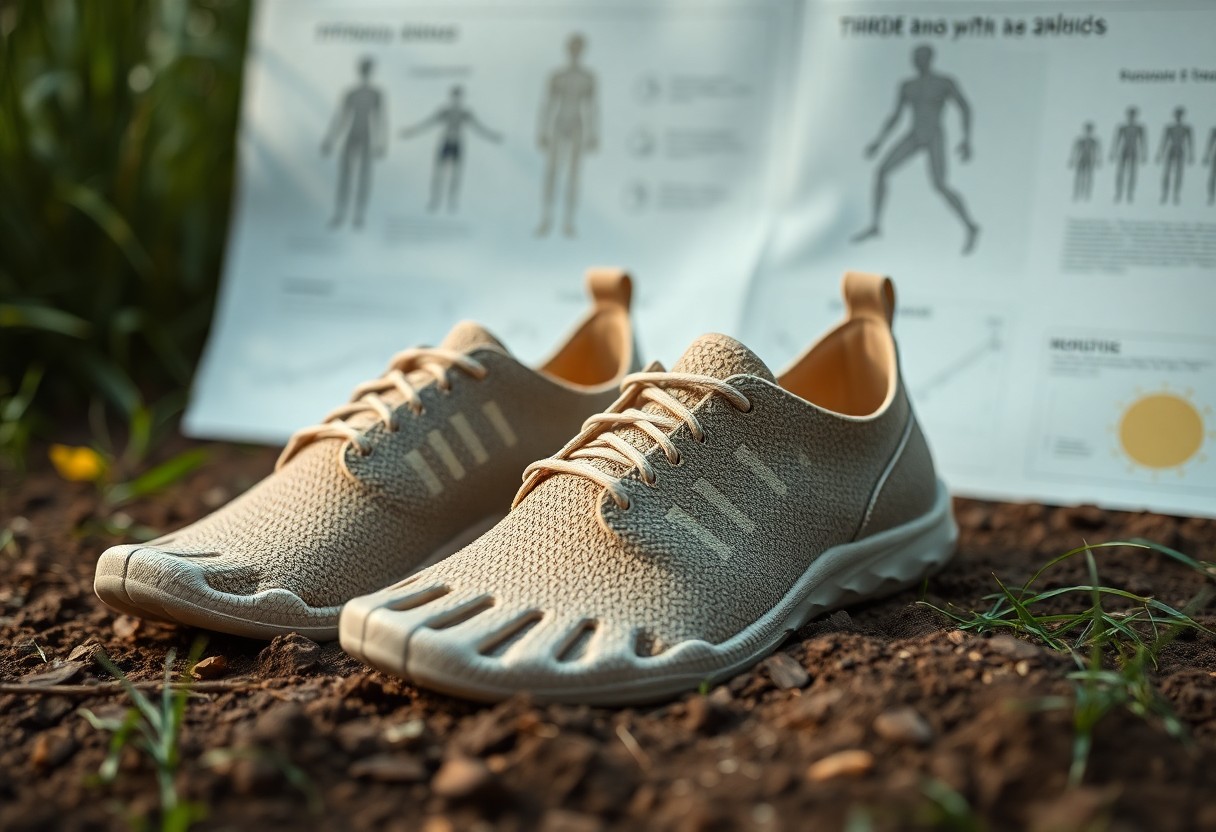Embracing sustainable design in footwear transcends the mere act of waste reduction; it plays a pivotal role in enhancing foot health as well. <a href="https://myshoesfinder.com/barefoot-shoes-comfort-for-teachers-all-day/">Barefoot shoes</a> are at the forefront of a transformative movement within the industry, dramatically decreasing CO₂ emissions through the incorporation of groundbreaking materials and streamlined production techniques. When you opt for these eco-conscious designs, you are not only supporting your own health but also contributing to a vision of a future where biomechanical optimisation aligns seamlessly with environmental responsibility. Become a part of the expanding movement that champions footwear designed for both your physical well-being and the health of our planet. Extensive lifecycle assessments reveal how minimalist shoe designs can significantly lower your carbon footprint, positively influencing both personal wellness and ecological sustainability.
Revolutionising Footwear Production to Achieve Environmental Sustainability
To truly reshape the landscape of footwear production, it is imperative to adopt innovative strategies that effectively reduce the environmental footprint linked to this sector. The footwear industry is a considerable contributor to global CO₂ emissions, making it essential to embrace sustainable practices that prioritise ecological integrity while also protecting consumer health. By concentrating on advanced material sourcing, enhancing manufacturing efficiency, and crafting robust end-of-life management strategies, the footwear industry can make significant strides in reducing its carbon footprint. This critical transition not only benefits the environment but also aligns with the increasing consumer demand for responsible and sustainable products that reflect a commitment to a healthier planet.
Adopting Innovative Materials to Promote Environmental Sustainability
Progressive brands are enthusiastically embracing disruptive material innovations to significantly lessen their environmental impact. For instance, Xero Shoes’ dedication to using materials such as hemp and recycled PET not only reduces production emissions by an astounding 32% but also aligns with the rising consumer demand for sustainable products. This strategic pivot protects local ecosystems and fosters a circular economy by actively reducing waste throughout the manufacturing process. By prioritising these environmentally-friendly materials, brands can enhance their commitment to sustainability while appealing to an increasingly conscientious consumer base that values ethical production practices.
Conducting Lifecycle Analyses to Identify Opportunities for Carbon Footprint Reduction
Implementing thorough lifecycle analysis is vital for accurately evaluating the overall carbon footprint associated with footwear products. By scrutinising each phase—from material sourcing and manufacturing to usage and eventual disposal—you can uncover critical areas that require enhancement. For example, the typical emissions linked with barefoot shoes range between 10-20 kg CO₂e per pair, illustrating a remarkable 40% decrease when compared to conventional athletic footwear. Initiatives such as Vivobarefoot’s ReVivo programme, which extends the lifespan of shoes and diminishes emissions to a mere 5.8 kg CO₂e, demonstrate the substantial advantages that sustainability measures can confer on production efficiency while enhancing consumer appeal.
Optimising Foot Health through Biomechanics and Barefoot Shoe Design
The integration of biomechanics into the design philosophy of barefoot shoes amplifies the myriad benefits that minimalist footwear offers, leading to improvements in both foot health and sustainability. By prioritising natural foot movement, these shoes enable your feet to function as they were originally designed, fostering better posture and significantly lowering the risk of injuries. The lightweight construction of barefoot shoes promotes a more efficient gait, making each step feel more comfortable and exerting less strain on your body. This not only supports your personal health but also contributes to ecological well-being, as every step taken in these shoes is a step towards a sustainable future.
How Minimalist Footwear Designs Optimise Gait and Natural Movement
Minimalist designs inherent in barefoot shoes encourage a natural gait that favours midfoot or forefoot striking patterns. This adjustment can considerably diminish the impact force on your joints, resulting in a more efficient and enjoyable walking or running experience. By forgoing excessive cushioning and support, these shoes allow your foot muscles to engage fully, thus strengthening the intrinsic musculature essential for optimal movement. This natural approach to footwear not only boosts your physical performance but also cultivates a deeper connection with the ground, enriching your overall engagement in physical activities.
Exploring Energy Efficiency in Movement: Key Scientific Findings
Recent scientific research underscores the vital importance of energy efficiency in the performance of barefoot shoes. Studies have shown that runners donning barefoot footwear experience a notable enhancement in energy return and propulsion mechanics, leading to reduced fatigue and a more sustainable running style. This directly contributes to your movement efficiency during prolonged activities, making each step more productive. Enhanced energy efficiency is intricately linked to the thoughtful design of barefoot shoes, which facilitates improved biomechanics. For instance, trials involving 15 participants indicated that those wearing minimalist shoes made from algae-foam materials experienced an energy return rate of 89%, compared to just 82% for traditional EVA foams. This dynamic essence of barefoot footwear allows for a more natural range of motion, significantly alleviating knee stress during various activities. By harnessing these advantages, barefoot shoes emerge not only as an environmentally friendly choice but also as a pioneering solution for attaining optimal energy efficiency in motion.

Consumer Trends: Deciphering the Growing Demand for Sustainable Footwear
Understanding consumer motivations is essential for promoting the widespread adoption of sustainable footwear. Modern buyers are increasingly prioritising ecological and health benefits, gravitating towards products that meet their functional needs while also resonating with their personal values concerning environmental stewardship and overall well-being. As awareness of sustainability continues to grow, consumers actively seek out footwear brands that embody these principles, demonstrating a clear shift in purchasing preferences.
Identifying Trends Among Eco-Conscious Consumers and Their Preferences
With sustainability becoming a fundamental value, eco-conscious consumers are increasingly searching for footwear brands that reflect these ideals. Recent statistics indicate that 43% of shoppers are willing to pay a premium of 30% for sustainably produced shoes, highlighting a significant transformation in consumer priorities towards eco-friendly materials and practices. This trend emphasises the increasing importance of sustainability as a pivotal factor in purchasing decisions, motivating brands to adopt more responsible production methods that align with consumer expectations.
Understanding the Perceived Value of Sustainability in Footwear Choices
The perception of value surrounding sustainability in footwear is not merely a fleeting trend; it constitutes a central aspect of consumers' purchasing decisions. As a buyer, you are likely influenced by environmental considerations, health advantages, and assurances of durability, with research suggesting that perceived environmental benefits rank highest among consumer motivations. By choosing sustainable footwear, you support a broader movement towards responsible consumption that resonates deeply with many modern buyers today.
This growing awareness of environmental impact shows that consumers appreciate brands that prioritise sustainable features. Such perceptions of value foster stronger brand loyalty and can amplify the effects of your purchasing decisions, encouraging manufacturers to invest in greener practices and materials. Ultimately, sustainability enhances the perceived worth of a product, aligning your choices with larger environmental objectives while effectively satisfying your footwear needs.
Navigating the Evolving Regulatory Landscape for Sustainable Footwear Innovation
The ever-changing regulatory framework plays a significant role in steering the footwear industry towards sustainable innovation. With increasing scrutiny over carbon emissions and environmental degradation, new regulations are being implemented to promote greener practices within manufacturing processes. Complying with these emerging mandates addresses urgent environmental concerns and aligns with consumer expectations, compelling brands to innovate responsibly and transparently while meeting compliance standards.
Understanding Compliance Mandates: A Catalyst for Sustainable Practices
Emerging compliance mandates, particularly within the European Union, are establishing the foundation for sustainable practices across the footwear industry. By 2027, regulations will mandate a minimum of 20% recycled content in footwear materials, while carbon labelling will become compulsory for all athletic shoes by 2026. These guidelines challenge brands to reevaluate their material sourcing, production processes, and end-of-life strategies, ensuring greater accountability and environmental stewardship throughout the industry.
Leveraging Regulation to Foster Innovation: Opportunities and Challenges
While new regulations may introduce various challenges, they also create innovative opportunities for brands willing to adapt. Embracing compliance mandates encourages companies to invest in sustainable technologies, developing solutions that reduce carbon footprints while simultaneously enhancing overall product performance. For instance, brands are exploring biodegradable materials and advanced manufacturing techniques that can lead to improved durability and significantly decreased waste. However, navigating the complexities of regulatory compliance requires an agile approach, as organisations must balance sustainability objectives with market demands and cost considerations.
In light of these challenges, the regulatory landscape fosters a culture of innovation that encourages the development of new materials and processes. Adopting technologies such as 3D printing and biobased materials not only aligns with compliance requirements but also uncovers unique branding opportunities that resonate with environmentally conscious consumers. Brands willing to embrace these transformative changes will distinguish themselves in a competitive marketplace, driving progress while adhering to rigorous environmental standards. By viewing regulation as an opportunity rather than an obstacle, you can position your brand at the forefront of the sustainable footwear movement.
Imagining the Future of Footwear: The Convergence of Technology and Sustainability
The intersection of technology and sustainability is fundamentally transforming the footwear industry. As manufacturers leverage advanced materials and integrate smart features, the next generation of shoes promises not only improved performance but also a significant reduction in environmental impact. Innovations like 3D printing and intelligent systems are paving the way for designs that cater to your foot health needs while simultaneously promoting ecological integrity. This dynamic evolution reflects a deepening commitment to merging functionality with environmental responsibility within the footwear sector.
Integrating Smart Features into Footwear: Enhancing User Experience and Ecological Impact
Smart features in footwear greatly enhance your experience while simultaneously contributing to sustainability objectives. By embedding sensors within shoes, real-time feedback on your gait can be provided, enabling you to optimise performance and effectively minimise injury risks. Additionally, these innovations frequently utilise eco-friendly materials, ensuring that your athletic pursuits are harmoniously aligned with your desire to protect the environment.
Customisation and On-Demand Production: The Role of 3D Printing in Sustainable Footwear
On-demand production harnesses the power of 3D printing technology to create shoes tailored specifically to your individual needs. This cutting-edge approach not only facilitates a customised fit but also significantly diminishes waste generated by traditional manufacturing methods. By employing advanced 3D printing techniques, brands can produce footwear that accurately reflects individual foot dimensions based on pressure mapping and various biometric data. This level of customisation reduces the likelihood of returns and excess inventory, with studies indicating a 73% reduction in waste through on-demand manufacturing practices. Furthermore, localised production decreases transportation emissions and bolsters regional economies. As brands adopt this technology, you gain access to footwear that is not only better suited to your feet but also more environmentally responsible.
Embracing Your Role in the Sustainable Footwear Revolution
In summary, the innovations surrounding sustainable footwear are reshaping the industry by harmonising biomechanics with environmental responsibility in barefoot shoe design. By incorporating minimalist footwear into your lifestyle, you can enhance your foot health while making a significant impact on your carbon footprint. Choosing shoes that prioritise sustainable materials and ethical manufacturing practices supports a transformative shift towards a more eco-conscious market. Embracing these advancements not only benefits you personally but also contributes to the overarching goal of planetary well-being, fostering a future where functionality and sustainability coexist in perfect harmony.
The Article Sustainable Footwear Innovation: Bridging Biomechanics and Environmental Responsibility in Barefoot Shoe Design appeared first on My Shoes Finder
The Article Sustainable Footwear Innovation in Eco-Friendly Barefoot Design Was Found On https://limitsofstrategy.com







